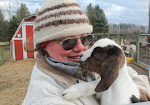 Miss Bango, a Foundation-bred Quarter Horse, and I have been companions for fifteen years as of this month. Despite everyone's belief that when I bought the farm I'd soon have a whole barn full of the four legged beasts, I'm a one-horse kind of gal. As a matter of fact, I think the last time I rode a horse other than my own was three years ago when I was in California for a visit and took Rocket my buddy, Tim's Palomino up Sisar Canyon in Ojai with some of my old trail pals.
Miss Bango, a Foundation-bred Quarter Horse, and I have been companions for fifteen years as of this month. Despite everyone's belief that when I bought the farm I'd soon have a whole barn full of the four legged beasts, I'm a one-horse kind of gal. As a matter of fact, I think the last time I rode a horse other than my own was three years ago when I was in California for a visit and took Rocket my buddy, Tim's Palomino up Sisar Canyon in Ojai with some of my old trail pals.As the years go by, you learn to recognize your horse's facial expressions and moods. I knew early on that Bango was incredibly jealous and any time she would see me riding or driving other horses, she would turn her back to me and squeal. So when Andy showed up in her pasture on Sunday, needless to say she glared at him with pursed lips and stomped indignantly in her stall.
Monday and Tuesday delivered miserable cold rain and driving bitter winds. Being a priss, I knew the old red mare would resent being turned out so she stayed in her stall brooding about the big blond Belgian she could see from the barn. He would whinny, but she refused to respond.
Finally, I turned her out into the front pasture yesterday. I knew that if I put her in the big pasture with the big horse, she'd make a bee-line for him and proceed to beat the living daylights out of the poor guy.
At first, she kept her distance from the fence line, snorting and prancing, deciding to investigate while Andy stood patiently on his side of the fence waiting for an introduction. Visibly full of attitude, she approached the fence. Both horses stood face to face, their necks arched and silently exchanged greeting for several seconds before the silence and stillness was broken by a blaze of red squealing, kicking and stomping that sent the behemoth of a gelding dashing across the pasture like the devil herself was after him. Cautiously, he neared the fence again and the whole process repeated. After a few episodes of this game, Andy grew bored and went back to grazing. Bango stuck near the fence and cursed at him the rest of the afternoon.





































